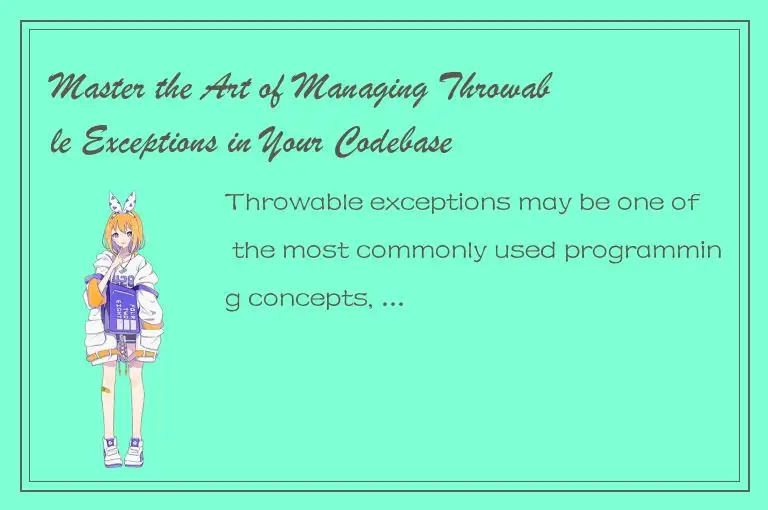Throwable exceptions may be one of the most commonly used programming concepts, but they can also be one of the most complicated to manage in your codebase. As a developer, your primary goal is to create programs that are reliable, efficient, and scalable. And one of the ways you can achieve this is by mastering the art of managing throwable exceptions in your codebase.

What are Throwable Exceptions?
Throwable exceptions are errors or unexpected events that occur during the execution of a program. They include runtime exceptions, errors, and checked exceptions. In Java, for example, all exceptions extend the Throwable class, which means that they can be thrown and caught as needed.
Despite their usefulness, throwable exceptions can take a toll on your program's performance and reliability, so it's important to understand how to manage them effectively.
The Importance of Managing Throwable Exceptions
Throwable exceptions can seriously impact the performance and reliability of your program. They can cause your program to shut down unexpectedly, generate error messages, or leave your program in an unstable state. But by managing them carefully, you can significantly reduce the likelihood of these issues occurring.
Effective error management requires careful planning and foresight. It involves understanding common errors and exceptions that might arise in your program and developing a strategy to handle them gracefully.
Here are some strategies to consider when managing throwable exceptions in your codebase:
1. Define and Document Your Exceptions
When using throwable exceptions in your codebase, it's important to document them clearly and succinctly. Doing so helps to ensure that you and other developers understand how to use them and what they are intended for. It will make it easier to identify the source of errors when something goes wrong.
2. Use Custom Exceptions
While Java comes with many built-in exceptions, it's often useful to create custom exceptions for your program. Custom exceptions can provide more detailed information about the type of error that occurred, allowing you to handle it more effectively.
For example, suppose you're building a program that manages financial data. In that case, you might create custom exceptions for specific types of financial errors to make it easier to identify and resolve issues.
3. Handle Exceptions Gracefully
Handling exceptions gracefully is essential to creating a reliable and stable program. It involves catching and handling exceptions in such a way that they don't cause your program to shut down unexpectedly.
For example, suppose your program encounters a FileNotFoundException when trying to read a file. In that case, you might catch the exception and inform the user that the file couldn't be found, instead of crashing the entire program.
4. Use Try-Catch-Finally Blocks
To effectively manage throwable exceptions, you'll need to use try-catch-finally blocks. Try-catch-finally blocks provide a way of testing code for potential errors while simultaneously handling them.
The try block contains the code that you want to test for errors; the catch block contains the code that handles the errors, and the finally block contains code that must be executed regardless of whether an error occurred or not.
5. Test Your Code Thoroughly
Testing your code thoroughly is essential to catching and resolving errors before they become a problem. You'll need to test all possible input scenarios and error conditions to ensure that your program can handle them gracefully.
Tools like JUnit can automate much of the testing process, making it easier to ensure that your code works as intended.
Conclusion
Throwable exceptions are an essential feature of modern programming, but they also require careful management to ensure that your program remains stable and reliable. By defining your exceptions, using custom exceptions, handling them gracefully, and testing your code thoroughly, you can create a program that is both efficient and robust.




 QQ客服专员
QQ客服专员 电话客服专员
电话客服专员